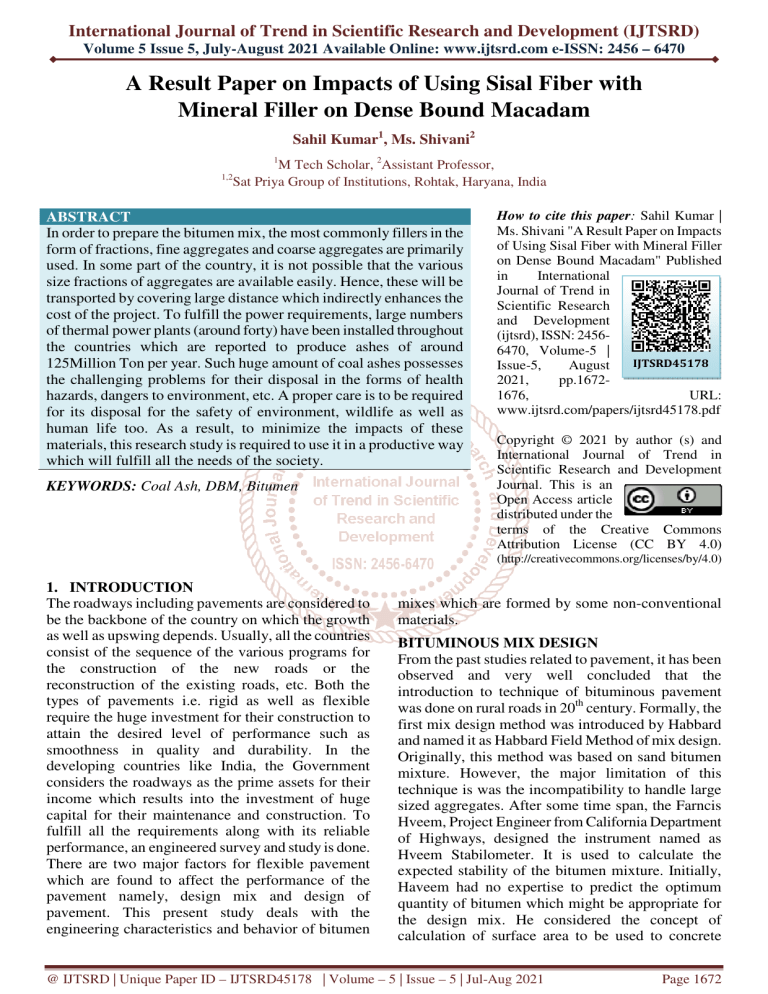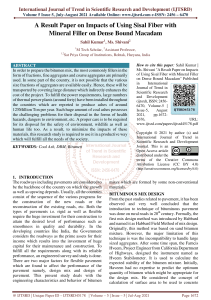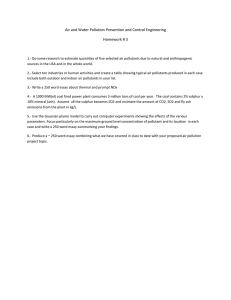
International Journal of Trend in Scientific Research and Development (IJTSRD)
Volume 5 Issue 5, July-August 2021 Available Online: www.ijtsrd.com e-ISSN: 2456 – 6470
A Result Paper on Impacts of Using Sisal Fiber with
Mineral Filler on Dense Bound Macadam
Sahil Kumar1, Ms. Shivani2
1
M Tech Scholar, 2Assistant Professor,
1,2
Sat Priya Group of Institutions, Rohtak, Haryana, India
ABSTRACT
In order to prepare the bitumen mix, the most commonly fillers in the
form of fractions, fine aggregates and coarse aggregates are primarily
used. In some part of the country, it is not possible that the various
size fractions of aggregates are available easily. Hence, these will be
transported by covering large distance which indirectly enhances the
cost of the project. To fulfill the power requirements, large numbers
of thermal power plants (around forty) have been installed throughout
the countries which are reported to produce ashes of around
125Million Ton per year. Such huge amount of coal ashes possesses
the challenging problems for their disposal in the forms of health
hazards, dangers to environment, etc. A proper care is to be required
for its disposal for the safety of environment, wildlife as well as
human life too. As a result, to minimize the impacts of these
materials, this research study is required to use it in a productive way
which will fulfill all the needs of the society.
KEYWORDS: Coal Ash, DBM, Bitumen
How to cite this paper: Sahil Kumar |
Ms. Shivani "A Result Paper on Impacts
of Using Sisal Fiber with Mineral Filler
on Dense Bound Macadam" Published
in
International
Journal of Trend in
Scientific Research
and Development
(ijtsrd), ISSN: 24566470, Volume-5 |
IJTSRD45178
Issue-5,
August
2021,
pp.16721676,
URL:
www.ijtsrd.com/papers/ijtsrd45178.pdf
Copyright © 2021 by author (s) and
International Journal of Trend in
Scientific Research and Development
Journal. This is an
Open Access article
distributed under the
terms of the Creative Commons
Attribution License (CC BY 4.0)
(http://creativecommons.org/licenses/by/4.0)
1. INTRODUCTION
The roadways including pavements are considered to
be the backbone of the country on which the growth
as well as upswing depends. Usually, all the countries
consist of the sequence of the various programs for
the construction of the new roads or the
reconstruction of the existing roads, etc. Both the
types of pavements i.e. rigid as well as flexible
require the huge investment for their construction to
attain the desired level of performance such as
smoothness in quality and durability. In the
developing countries like India, the Government
considers the roadways as the prime assets for their
income which results into the investment of huge
capital for their maintenance and construction. To
fulfill all the requirements along with its reliable
performance, an engineered survey and study is done.
There are two major factors for flexible pavement
which are found to affect the performance of the
pavement namely, design mix and design of
pavement. This present study deals with the
engineering characteristics and behavior of bitumen
mixes which are formed by some non-conventional
materials.
BITUMINOUS MIX DESIGN
From the past studies related to pavement, it has been
observed and very well concluded that the
introduction to technique of bituminous pavement
was done on rural roads in 20th century. Formally, the
first mix design method was introduced by Habbard
and named it as Habbard Field Method of mix design.
Originally, this method was based on sand bitumen
mixture. However, the major limitation of this
technique is was the incompatibility to handle large
sized aggregates. After some time span, the Farncis
Hveem, Project Engineer from California Department
of Highways, designed the instrument named as
Hveem Stabilometer. It is used to calculate the
expected stability of the bitumen mixture. Initially,
Haveem had no expertise to predict the optimum
quantity of bitumen which might be appropriate for
the design mix. He considered the concept of
calculation of surface area to be used to concrete
@ IJTSRD | Unique Paper ID – IJTSRD45178 | Volume – 5 | Issue – 5 | Jul-Aug 2021
Page 1672
International Journal of Trend in Scientific Research and Development @ www.ijtsrd.com eISSN: 2456-6470
design mix, to determine the amount of bitumen
essentially required for the mix. Meanwhile, other
equipment was also designed by Bruce Marshall
during 1930’s, to determine the deflection of the mix
along with its stability.
The bituminous design mix is the combination of
stone chips having gradations between the nominal
highest size of aggregates and finer fractions lesser
than 75 microns along with some quantity of bitumen.
It should be mixed and produced such that it might be
compacted sufficiently with smaller size of voids and
constitute to produce its destructive and elastic
characteristics. The main objective this design mix is
to calculate the adequate ratio of bitumen and
fractions of aggregate to form an effective mix which
has to be essentially durable, economical and reliable.
2. REVIEW OF LITERATURE
A Research has been carried out by Manimaran E
and Mohan Kumar G (2017) that higher
concentration of bottom ash reduces the slump Value
and to make the mix workable we need some extra
amount of water. The characteristic strength of the
pavement mix was observed to be 3% more than that
was easily obtained by lowest molarity 8M of NaOH
both in hot and ambient curing.
Patankar S.V (2018) studied the effect of various
concentrations on the strengthj of bottom ash based
concrete onj amount ofj sodium hydroxidej solutionj
in terms of Molarity to bottomj ashj ratio 0.30, 0.35,
0.40 on workabilityj in terms ofj flow plastic state.
This research showed that compressive strengthj
increases in increases in amount of sodium hydroxide
solj in terms of molarity. Theyj recommended 13M
solution on the basis ofj workability and compressive
strength.
Sudhakarreddy K (2020) reported that 6% of
replacements of cement in fly bottom ash in the
bituminous design mix yield the good results in
flexure strength of the pavement.
3. RAW MATERIALS
A consistent mix formed by the aggregates having
gradations form highest fraction to smallest fraction
ranging from I.S. 25mm size to filler, smaller than
I.S. 75 micron size with the bitumen binder, blended
together to form a the bituminous mix. The mix is
laid and compacted such as to attain the elastic body,
hard and non-porous in nature. This present study is
to calculate the most appropriate the ratio of
aggregates, fillers, bitumen and some other additives
if required.
The design of bituminous mix includes the process of
calculating the ratio of bitumen, fine aggregates,
coarse aggregates and filler. This design mix must be
strong enough, durable, economical and workable.
The basic materials which are used for the mix are
listed below:
1. Bituminous Binder
2. Fly Ash
3. Aggregates
4. Slag
5. Additve
4. EXPERIMENTAL WORK
To ensure the required level of performance, the
above defined gradation of aggregates is used for the
following test:
1. Marshall Test for mixes for their volumetrical
analysis
2. Splitting Tensile Strength Test / Static Indirect
Test for tensile strength
3. Static Creep Test
4. Tensile Strengthj Ratio Test (Resistance to
Moisture Damage)
5. Retained Stability Test
DESIGN MIX
According to specifications from the Marshall
procedure defined in ASTM-D-6927 (2015), all the
constituents of the mixes like filler, fine aggregates,
coarse aggregates, fiber and VG – 30 bitumen are
mixed thoroughly as per the specifications. Before the
preparations of the specimens, the coating of fibers is
done with emulsion SS – 1 and kept at controlled
temperature conditions of around 1100° C for 24
hours. This condition mainly helps the fibers to
sustain a proper coating around it and the extra
amount of the bitumen to be drained out. The
different specified lengths of fibers for the test are
kept as 20 mm, 15 mm, 10 mm and 5 mm
respectively. The heating of aggregates and bitumen
takes place in the temperature range of about 1550° 1600° C. It is interesting to note that the temperature
of the aggregates should be around 100° C above the
temperature of the binders. The desired amount of the
VG – 30 bitumen and fibers having emulsion layer
are added to pre-heated aggregates and completely
mixed
@ IJTSRD | Unique Paper ID – IJTSRD45178 | Volume – 5 | Issue – 5 | Jul-Aug 2021
Page 1673
International Journal of Trend in Scientific Research and Development @ www.ijtsrd.com eISSN: 2456-6470
5. RESULTS
Fiberj
content, %
0.25
Fiberj
content, %
0.5
Fiberj
content, %
0.75
Fiberj
content, %
1
Fiberj
length, mm
0
5
10
15
20
Fiberj
length, mm
0
5
10
15
20
Fiber
length, mm
0
5
10
15
20
Fiberj
length, mm
0
5
10
15
20
Table : Analysis of Marshall Characteristics
OBC,
Optimum
Flow value,
VA,
%
stability, kN
mm
%
5.60
11.40
3.15
2.40
5.70
14.20
4.00
3.60
5.78
13.20
3.50
3.60
5.87
12.80
3.80
3.10
5.73
11.90
3.80
4.00
OBC,
Optimum
Flow value,
VA,
%
stability, kN
mm
%
5.60
11.40
3.15
2.40
5.57
13.80
3.85
2.90
5.60
15.00
3.50
2.80
5.80
11.50
3.60
4.30
6.13
12.00
4.90
4.00
OBC,
Optimum
Flow value,
VA,
%
stability, kN
mm
%
5.60
11.40
3.15
2.40
5.90
12.20
3.70
3.60
5.77
13.30
3.10
2.20
6.00
12.50
3.40
4.00
6.13
12.30
3.50
4.30
OBC,
Optimum
Flow value,
VA,
%
stability, kN
mm
%
5.60
11.40
3.15
2.40
5.93
12.30
4.20
3.70
5.77
12.50
3.40
4.40
5.55
13.40
3.20
2.90
5.63
12.65
3.8
2.40
VMA,
%
15.30
16.70
17.00
16.60
17.00
VMA,
%
15.30
17.10
15.80
17.60
17.90
VMA,
%
15.30
17.30
15.90
17.90
18.35
VMA,
%
15.30
17.60
17.65
16.10
16.20
VFB,
%
84.00
79.00
76.00
80.00
77.00
VFB,
%
84.00
75.00
82.00
76.00
78.00
VFB,
%
84.00
80.00
86.00
78.00
77.00
VFB,
%
84.00
80.00
76.00
82.00
83.00
Gmb
2.33
2.28
2.28
2.27
2.27
Gmb
2.33
2.26
2.30
2.25
2.24
Gmb
2.33
2.26
2.30
2.25
2.24
Gmb
2.33
2.24
2.24
2.28
2.28
STATIC INDIRECT TENSILE STRNGTH TEST
For this test, the cylindrical shaped Marshall specimen is subjected to load in compression at rate of 5.1 cm per
minute such that the loading planes are parallel along the perpendicular diametrical planes by the use of curved
strips of stainless steel. The radius of curvature is quite similar to the radius of curvature of sample. Initially, the
specimen is kept in the water bath to maintain at some specified temperature for 30 minutes before testing. It
should be noted that the same temperature has to be maintained during testing. The applied configuration of
external load generates a comparative uniform stress in tension normal to the direction of load applied and along
the diametric planes also. Interestingly, the failure of specimen is done by the splitting action along the vertical
plane of the diameter.
2XP
Indirect / Splitting Tensile Strength =
NXDXT
Where, P = Maximum Value of Load Applied (in KN),
T = Height ofj Specimen just before test (in mm),
D = Diameter of Specimen (in mm)
The testing temperature varies in the range of 5° to 40° C with constant increase of 5°C temperature. The final
result of tensile strength is taken as the average value taken from the three testing results of the specimens.
@ IJTSRD | Unique Paper ID – IJTSRD45178 | Volume – 5 | Issue – 5 | Jul-Aug 2021
Page 1674
International Journal of Trend in Scientific Research and Development @ www.ijtsrd.com eISSN: 2456-6470
Fig. : Variation of Tensile Strength with respect to Temperature
This test is conducted on four types of specimens as given below:
1. Specimen with coal ash only
2. Specimen with fiber only
3. Specimen without coal ash and fiber
4. Specimen with coal ash and fiber both
The graphical figure 5.32 shows that the indirect strength in tension gets reduced with rise of temperature but
this strength gets increased with coated fibers along with the coal ash are used for the preparation of DBM
specimen. It may be due to texture of fibers used. It is also interesting to note that the contribution of coal ash
helps to enhance the marginal rise in tensile strength when compared to the traditional design mix.
RATIO OF TENSILE STRENGTH (TSR)
Table shows that values of ratio of tensile strength of two various kinds of mix i.e. one is modified in nature
while the other unmodified in nature. It is noted that when the coal ash and sisal fibers are used together, the
resistance against the damage due to moisture of the DBM designed mix gets increased. It might be possible due
to the fact that modified mix of BM consists of lesser air voids as compared to that of unmodified mix. When the
design mix is prepared any of the content between coal ash or sisal fiber, a certain amount of resistance to
damage susceptibility due to moisture is attained.
Table : Ratio of Tensile Strength
Ratio of Tensile Strength
Design Considerations
Mix Types
DBM containing coal ash DBM Without coal ash
At least 80% (refer to
DBM With Sisal fiber
83.00%
81.09%
MORTH specification)
DBM Without Sisal fiber
83.12%
79.98%
STATIC CREEP TEST
This test is a tool to measure the permanent deformations subjected to the consistent loading for large time
interval. Fig. 5.33 shows the graphical variations between deformations and time such that minimum
deformations for the DBM specimens are observed with 10 mm length of fiber, 0.5 % content of fiber, 14 % coal
ash and optimum content of binder is 5.7 % by weight of the mix.
@ IJTSRD | Unique Paper ID – IJTSRD45178 | Volume – 5 | Issue – 5 | Jul-Aug 2021
Page 1675
International Journal of Trend in Scientific Research and Development @ www.ijtsrd.com eISSN: 2456-6470
Fig: Deviations of Deformation for DBM specimens with time at temp.
6. CONCLUSION
The experimental approach to the present research
work draws the following conclusions:
1. The Marshall tests concludes that Dense
Bituminous Macadam designed mixes are formed
by the addition of fly ash particles passing
through 0.075 microns and bottom ash particles
that lies in the range of 0.075 mm to 300 mm.
These mixes are found to be the best design mixes
that fulfills the criteria as per the Marshall tests
such that the bituminous concentration, length of
fibers ad their concentration used are 5.7%, 10
mm and 0.51% respectively.
2. It is interesting to note that the flow values and
values of Marshall Stability obtained falls under
the acceptable range of criteria provided that the
content of coal ash remains within 15 % range.
3. It is noted that the flow value of the mixes gets
reduced drastically with rise in the length of fiber
and its content along with the concentration of air
voids. In contrast to this, the increase in the value
of Marshall Quotient takes place which results
into the increase in stability value of the mixes.
4. It is also concluded that the requirements for the
optimum content of bitumen and emulsions to be
used for the fiber coating increases with rise of
length of fibers and its content.
5. The various tests that are used to measure the
various tensile strength values of concrete
indicates that the strength of concrete in tension
of the specimen increases by the adding coal
ashes and the fibers having emulsions coating. It
results into very wide improvements to the
engineering properties for DBM specimens
against cracking due to thermal changes.
6. The utilization of coal ash, fibers having emulsion
coating or both to the Dense Bound Macadam
design mixes imparts the higher resistance against
the damage by the moisture in the form of ratio of
tensile strength of the mixes along with the
stability values.
7. REFERENCES
[1] Musselman, C. N., Taylor Eighmy, T., Gress,
D. L., & Killeen, M. P.; “The New Hampshire
Bottom Ash Paving Demonstration US Route 3,
Laconia, New Hampshire.” NATIONAL
WASTE PROCESSING CONFERENCE. Vol.
16.
MECHANICAL
ENGINEERING
PUBLICATIONS LTD, (1994).
[2] Part l, M., Sokolov, K., & Kim, H.; "Evaluating
and Modeling the Effect of Carbon Fiber Grid
Reinforcement in a Model Asphalt Pavement."
(2008).
[3] Putman, B. J., & Amirkhanian, S. N.;
“Utilization of waste fibers in stone matrix
asphalt mixtures.” Resources, conservation and
recycling 42.3 (2004): 265-274.
[4] Shuler, T. S.; “The effects of bottom ash upon
bituminous sand mixtures” (1976).
[5] Sinha, A. K., Havanagi, V. G., Mathur, S., &
Guruvittal, U. K.; "Investigation and design of
a fly ash road embankment in India by CPT.",
(2009).
[6] Zeng, M., & Ksaibati, K.; “Evaluation of
moisture susceptibility of asphalt mixtures
containing bottom ash.” Transportation
Research Record: Journal of the Transportation
Research Board 1832.1 (2003): 25-33.
@ IJTSRD | Unique Paper ID – IJTSRD45178 | Volume – 5 | Issue – 5 | Jul-Aug 2021
Page 1676






